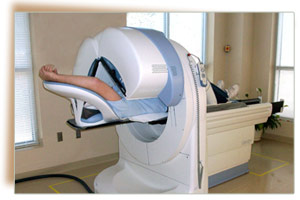Stress Testing

Stress testing is performed in the diagnostic laboratory in our Massaponax Medical Park office. The lab is equipped with four treadmills, three nuclear imaging cameras, and two ultrasound machines. Our laboratory staff, with more than 130 years of combined experience, is dedicated to providing the highest quality of personalized service to meet the needs of our patients. All stress tests are performed by specially trained nurse practitioners, physician assistants, or physicians. All testing is supervised by board certified cardiologists who are on-site with staff trained in emergency medical procedures to ensure the safety of patients during testing.
Please follow testing preparation instructions carefully to avoid being rescheduled. It is important to inform us immediately if you could be pregnant or have physical limitations that may prevent you from walking on a treadmill.
Exercise Stress Test
An exercise stress test is done to assess how the heart responds to physical activity and detect various forms of heart disease. This test combines mild exercise on a treadmill with an electrocardiogram (EKG) to record the electrical activity of the heart. This enables doctors to diagnose reduced blood flow to the heart muscle, abnormal heart rhythms, and other heart conditions. An exercise stress test may be done to determine the cause of chest pain, evaluate heart medications or procedures, or to determine appropriate exercise levels in those initiating an exercise program.
Download Testing Preparation Instructions for Exercise Stress Test
Nuclear Stress Test

A nuclear stress test uses a radioactive isotope to assess the blood flow to the heart muscle. Images of the heart are taken both at rest and after exercise. If a patient is unable to exercise on a treadmill, they are given a medication, by injection, intended to have a similar effect on the heart to that of exercise. This test enables doctors to identify areas of the heart that have reduced blood flow caused by coronary artery disease, as well as areas that have been damaged from a previous heart attack. A nuclear stress test may be done to determine the cause of symptoms such as chest pain and shortness of breath. It is also used to determine the severity of heart disease, the risk of heart attack, and to evaluate the results of a procedure such as cardiac catheterization or bypass surgery.
This test requires that you lie flat in the nuclear imaging camera on two occasions for 15-20 minutes. If you have symptoms of claustrophobia, we recommend that you obtain medication from your physician to help you complete the imaging portion. If you are unable to lie flat, please inform your physician so that an alternative test may be considered.
Download Testing Preparation Instructions for Nuclear Stress Test
Stress Echocardiogram
A stress echocardiogram combines an exercise stress test with an echocardiogram. An echocardiogram uses high frequency sound waves (ultrasound) to look at how the various parts of the heart are functioning at rest and after exercise. If the patient is unable to exercise on a treadmill, they are given a medication, by injection, which makes the heart beat stronger and faster, similar to exercise. A stress echocardiogram may be done to diagnose coronary artery disease, heart muscle or valve disease, to determine the severity of heart disease, or to evaluate the results of a procedure such as cardiac catheterization or heart surgery.
Download Testing Preparation Instructions for Stress Echocardiogram

